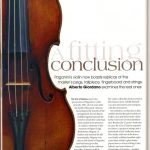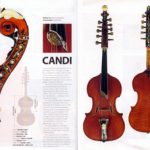The Strad magazine, April 2005 issue: In focus: Giovanni Francesco Pressenda
Copyright © 2013 Alberto Giordano – The Strad magazine. All rights reserved
Lequio Berria is still a small village lost in the solitary hills of the Langhe: Giovanni Francesco Pressenda was born in a modest farmstead just out of the village, in the fraction called Bordia on January 6th 1777: his parents, Anna Maria Boffa and Giovanni Raffaele were farmers. Traditionally considered son of an amateur violinst and musician himself, Pressenda was supposed to be trained in Cremona: latest researches demonstrate that in spite of the good education he received, he was a farmworker for a long time and he never attended cremonese workshops. His apprenticeship started in Torino soon after 1815 in the workshop of Leté-Pillement, an active shop dealing in different kind of musical instruments; he remained there a short time after the death of the keeper (Nicolas Leté died in 1819) and around 1821 Pressenda was able to open his own firm. Since then, due also to the support of the major torinese violin players Giovanni Battista Polledro and Giuseppe Ghebart, the reputation of Pressenda was consolidated and he started a consistent output of instruments.
It seems that in that french shop he learned not only the violin making technique but also the managing of the shop, since he always relied on the assistance of various collaborators: among them we can mention François Calot, Pierre Pacherel and Giuseppe Rocca. Pressenda died in Torino on December 12th 1854 in almost humble condition.
The violin hereby represented stands out in the production of Pressenda for its refined classical inspiration.
No label is left inside: it was probably made around 1845, in the last period of the author’s career. The interior shows the evidence of the interior mould with which the instrument was made since the central blocks are slightly splitted in the contact points. The arching of the belly is quite flat in the center and descends gently up to the scoop of the purfling; the elegant borders follows the style of Stradivari, while the elongated points of the purfling in the back reveal that ‘french taste’ of Pressenda. The drawing of the ef-holes is more mellow than usual: it’s courious that the fluting of the lower wings are different: in the e-side the scoop starts from the edge, while the g-side shows a border more close to Stradivari. The varnish that cover the instrument is still admirable for its delicate texture: in the interior are evident the crystals of ruby red varnish that penetrated the wood.
The Strad, april 2005 – in Focus on





